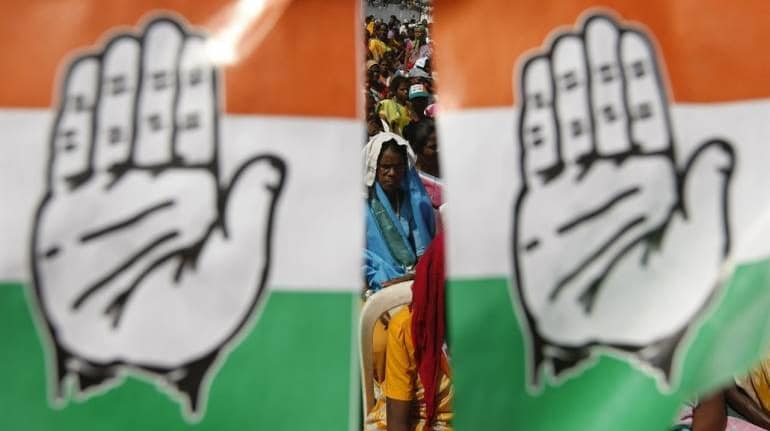



The Assembly elections of 2014, held before the bifurcation of Andhra Pradesh, was no less than a nightmare for the Congress.
Andhra Pradesh was regarded as a bastion for the party since the formation of the state in 1956. This was until Telugu matinee idol-turned-politician NT Rama Rao launched his Telugu Desam Party (TDP) in 1982, ending the single-party rule.
TDP ruled the state for much of the next two-and-half decades, before Congress found its feet again, under the leadership of YS Rajasekhara Reddy (popularly known as YSR).
YSR helped Congress win the state from TDP's N Chandrababu Naidu in Andhra Pradesh in 2004 and retained it in 2009 general and assembly elections.
But his untimely death in September 2009 spelt doom for the party in the state, which was later bifurcated into Telangana and Andhra Pradesh.
The vote share of Congress dropped from 36.69 percent in 2009 to 12.07 percent in 2014. The party was able to win just 21 seats (all in Telangana region) out of 286 seats it contested from in 2014, against winning 156 seats out of 294 contested seats in 2009.
The defeat in the Telangana region was a big setback for the party, which played a prominent role in carving it out as a separate state, as the voters preferred the regional Telangana Rashtra Samiti (TRS).
As Telangana inches closer to voting for a fresh government in the state, Congress is trying hard to win the battle this time.
Also read: Key facts about the 1st independent election of Telangana
Let's take a look at the key reasons behind Congress’ decimation in Telangana in 2014:
Anti-incumbency
The Congress had won and came to power in Andhra Pradesh in 2004 under chief minister YSR. The party then retained power in 2009. YSR continued as the CM of the state, but his term was abruptly cut short by his death on September 2, 2009. It was followed by the appointment of senior Congressman K Rosaiah as chief minister.
This is when came the twist in state politics, as YS Jaganmohan Reddy, son of YSR, revolted against the party.
The Congress leadership soon realized that Rosaiah was no match for the large leadership vacuum left by YSR. Also, given his old age, Jagan's open revolt and intensification of Telangana statehood agitation, the party decided to replace him with the much younger N Kiran Kumar Reddy.
Kiran Reddy's appointment was also seen as an attempt by the party leadership to placate the politically strong Reddy community that always aligned with the Congress as well as nullify Jagan's rebellion.
Jagan finally broke away from Congress with a few of his loyal MLAs and formed a regional party named YSR Congress.
The Congress managed to complete the tenure with the help of actor-turned-politician Chiranjeevi, who merged his Praja Rajyam Party (PRP) with the former.
The general anti-incumbency, in addition to infighting and the party's flip-flops on Telangana, led to political unrest and the administration was always under siege due to agitation.
Formation of Telangana
The demand of a separate Telangana state was first raised in 1969. After almost 40 years, the statehood demand took centrestage with K Chandrashekar Rao (KCR) sitting on a fast-unto-death in 2009. With KCR's health deteriorating and the Centre sensing law and order breakdown in the state, they bit the bullet by announcing the process for formation of the state on December 9. But it was soon put on the back burner for want of consultations.
Also read: Know the journey of the 'architect' of Telangana movement - KCR
It was only in 2014, ahead of Lok Sabha and AP assembly polls, the UPA government approved the division.
Though the Congress had perceived the decision as a way to gain support of people, it spinned negatively. The party was seen as pro-Telangana in AP (for letting the division) and anti-Telangana in the new state (for delaying the process).
This led to the party being turned into a cipher in Andhra and a loser in Telangana.
TRS emerging as champion of Telangana statehood cause
For Congress, the division of Andhra resulted in a stunning defeat. The party was decimated in Seemandhra and lost ground in Telangana, with the mandate going in favour of Telangana Rashtra Samithi (TRS) – a party formed with the single-point agenda of the formation of Telangana by K Chandrashekar.
Also read: Here's why the battle gets tougher for KCR this time
KCR and other TRS members managed to convince people that the state was granted as political compulsion and not to respect sentiments of the people.
Another reason was the mindset of voters in Telangana to have a ruling party that was solely dedicated to them.
This weighed heavily against Congress.
The Modi factor
Another factor that ate into Congress votes in 2014 was Narendra Modi and his popularity at the time.
The assembly elections for Telangana was held alongside 2014 Lok Sabha elections – which resulted in some gains for Bharatiya Janata Party (BJP).
Also read: Here are the key issues gaining steam ahead of elections
The BJP entered into an alliance with Chandrababu Naidu's Telugu Desam Party (TDP) and both parties together swept most constituencies in Greater Hyderabad, where there is significant Andhra settler population and resentment against Congress.
Out of the five seats BJP won in 2014, four — Musheerabad, Goshamahal, Khairatabad and Uppal — were ruled by Congress.
Assembly Elections 2018: Read the latest news, views and analysis here
Discover the latest Business News, Sensex, and Nifty updates. Obtain Personal Finance insights, tax queries, and expert opinions on Moneycontrol or download the Moneycontrol App to stay updated!
Find the best of Al News in one place, specially curated for you every weekend.
Stay on top of the latest tech trends and biggest startup news.